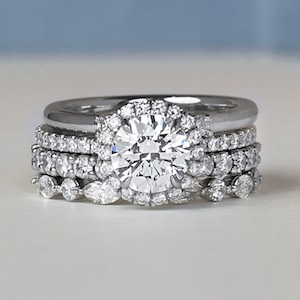
Millennial and Gen Z consumers are more likely than other age groups to buy fine jewelry this holiday, and they’re willing to do it at stores that take the proper COVID-19 precautions, a new survey from Platinum Guild International (PGI) found.
The online poll, designed to measure COVID-19’s impact on the jewelry market, found that 49% of Generation Z and 50% of millennial respondents will “definitely” or “probably” buy fine jewelry this holiday. By contrast, just 38% of the Generation Xers and 24% of baby boomers surveyed expressed the same buying intentions.
“Retailers should recognize and understand the younger generation is more likely to buy than the older generation this year,” says Jenny Luker, president of PGI USA. “They need to make sure that they are communicating to them in the way that they want to be communicated to and insuring that they have up-to-date websites and social media channels.”
The poll queried 1,000 U.S. consumers, ages 18–64, who have expressed interest in or have previously acquired fine jewelry, which is defined as jewelry costing at least $1,000 made with a precious metal.
Around 25% of respondents said they definitely will not buy jewelry this year. Cost was the biggest barrier to a purchase, cited by more than half of respondents.
Among those who did want to buy jewelry, 87% said they prefer to buy in a physical retail store. Of that group, 48% were interested in buying from a local independent jeweler, while 42% preferred a national jewelry chain like Kay. Also cited: department stores (27%), high-end retail stores like Tiffany or Saks (19%), and mass merchandisers (14%).
However, 70% also said they would be open to buying jewelry online, with Gen Z consumers the most open to the concept (77%) and boomers the least open (56%).
As far as their preferred online jewelry seller, 29% hoped to shop the website of a national chain, like Kay; 22% expressed interest in the website for a high-end retail store, like Tiffany; 21% would consider shopping the website of a local independent jeweler; 19% said they’d buy bling from Amazon.com; 18% would shop the website of an “everyday department store” like Macy’s or Kohl’s; and 11% were interested in the website of an online “pure play” retailer that specializes in jewelry, like Blue Nile.
Luker says she was “surprised” how many consumers felt comfortable visiting a retailer; only one-third of respondents expressed reservations about an in-person visit. Boomers (56%) and Gen Z consumers (58%) were less comfortable with the concept than millennials (67%) and Gen Xers (68%).
Yet, across the board, consumers wanted retailers to take standard COVID-19 precautions. As far as what would make them feel more comfortable shopping at a store, 49% said “seeing employees wearing masks at all times”; 49% answered “requiring customers to wear masks at all times”; 48% wanted stores to limit the number of customers allowed in the store at one time; 43% hoped retailers would enforce social distancing measures; 37% wanted hand sanitizer upon entering the store; and 31% expected retailers to post their policies for disinfecting jewelry pieces.
Luker says that, as hard as the pandemic has been on the jewelry business, it’s caused many retailers to up their digital game.
“The jewelry industry has moved into an omnichannel environment,” she says. “COVID has allowed people time to invest in digital and website and social media, and they are finding different ways to communicate with their consumers. We are seeing a lot of creativity and innovation.”
Top: A platinum engagement ring (image courtesy of Platinum Guild International)
- Subscribe to the JCK News Daily
- Subscribe to the JCK Special Report
- Follow JCK on Instagram: @jckmagazine
- Follow JCK on X: @jckmagazine
- Follow JCK on Facebook: @jckmagazine